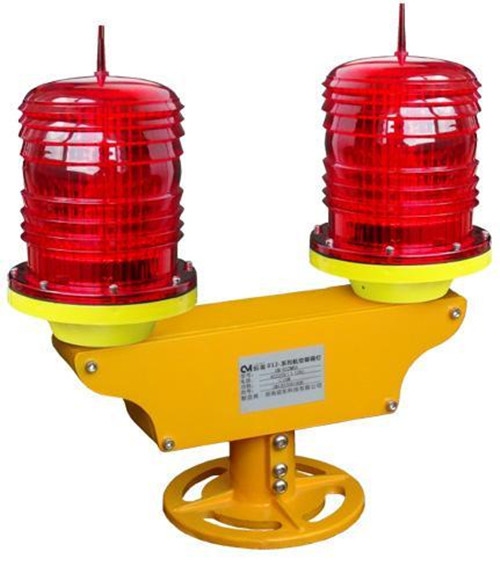Obstacle light setting place and range of residents difficult to sleep
The role of the aviation obstruction light is a special type of lamp used to identify obstacles. How can we distinguish the aviation obstruction light from other general-purpose lights? We should observe carefully that it should be possible to find that aviation obstruction lights are not constantly lit but are shining. In order to ensure flight safety, the frequency of aviation obstruction lights flashes. No less than 20 times and no more than 70 times per minute. With the aviation obstruction light pilots can determine the height and contour of the obstacles ahead. Since it is in the aviation field, safety issues are very important. Therefore, the obstruction light must be set in accordance with certain requirements, but not the slightest sloppy. Friends who are interested in aviation may wish to follow us to understand the scope and requirements of the obstacle light settings . Aviation Obstruction Lights The aviation obstruction light classification is divided into three categories from high to low: Gao Guangqiang aviation obstruction light, medium light aviation obstruction light, and low light intensity aviation obstruction light. 1. The Gaoguangqiang aviation obstruction light is used for obstacles that are more than 150 meters above ground level. In addition, it is required that the Type A and Type B high light intensity obstruction lights must be white flashes. All Type A high light intensity obstruction lights placed on an object must be flashed at the same time, and the B type high light intensity obstruction lights indicating the existence of overhead wires or cables to support the towers should be ordered. Flash: First is the middle light, then the top light, and finally the bottom light. 2. Zhongguang Qiang Aviation Obstruction Lights are obstruction lights used by obstacles that are located 45 to 105 meters above ground level. Divided into A type, B type, C type three. The type A medium light obstruction light must be a white flash, the type B must be a red flash, and the type C must be a red constant light. The type A and B light intensity obstruction lights on the same object must be fired at the same time. 3. The low-strength aviation obstruction light is an obstruction light used for obstacles whose height is less than 45 meters. There are two types: A type and B type. Type A, Type B, and Type C low-strength aeronautical obstruction lights must be red constant light when fixing objects, and C type low light intensity obstruction lights displayed on emergency and security vehicles must emit blue flashes The C-type low light intensity obstruction lights displayed on other vehicles must emit a yellow flash. The installation standards for aviation obstruction lights refer to the “Civil Aerodrome Flight Area Technical Standards†for the selection and installation of obstruction lights. Obstruction light installation and distribution 1. Obstacles should be marked with the highest point and the most edge of the obstruction (ie the apparent height and the apparent width) for the obstruction light. 2. If the top of the object is more than 45 meters above the ground around it, an obstruction light must be added to the middle of the object. The distance between the middle layer must be no more than 45 meters and be as equal as possible. Consider adding a barrier light to the middle layer.) When buildings in the vicinity of cities and residential areas are equipped with obstruction lights in the middle, consideration should be given to avoiding unpleasant residents. It is generally required to see only scattered light from the ground. 3. Obstruction lights set up in a large-scale building group should be able to see the outline of the object from various aspects, and the horizontal direction can also be referenced to set obstruction lights at a distance of about 45 meters. 4, for 105 meters of ultra-high objects, facilities or cable towers, towers and other rooftops, should be set at the top of its medium intensity A-type obstacle light, and a white flash, the lower part of the red light medium type B obstacles set light. 5. Ultra-high objects (eg, radio and television towers, large span cable-stayed bridges, etc.) over 150 meters should be equipped with a high light intensity type A type obstruction light at the top, and should be used with medium and high light intensity obstruction lights. 6. The ultra-high voltage transmission line tower should be equipped with a high-intensity B-type obstruction light and be synchronized with three flashes. The location is the top of the tower, the lowest point of the cable sagging, and the middle position between them, and it needs to be set outside the tower along the direction of the cable route. 7. For chimneys or other buildings of similar nature, the top obstruction light must be located between the top and the bottom of 1.5-3 meters. Considering that the chimney contaminates the light, the obstruction light can be installed at a position 4-6 meters below the chimney mouth (details) See national standards section). 8. Regardless of obstruction light, the number and arrangement of obstruction lights at different heights should be able to see the contour of the object or object group from all directions, and consider the synchronous flashing of the obstruction light to achieve a clear warning effect. Obstruction light setting place and scope The "Civil Aviation Law of the People's Republic of China" and related national documents clearly set up barrier lights: 1. Flight obstruction lights and signs should be set for high-rise or ultra-high buildings and structures in airport clearance areas. 2. Aircraft obstruction lights and signs should be set up on artificial and natural obstacle objects affecting flight safety on the route and around the flight area. 3. The aviation towering tall buildings and facilities that may affect flight safety should be equipped with aviation obstruction lights and signs and maintained in a normal state. ※ Public security, fire protection, transportation and other departments have a parking apron in the city, which is regarded as a clear space above the city. Barrier lights and signs should also be placed on tall buildings and structures in the city. Barrier lamp setup requirements 1. Obstacles should be marked with the highest point and the most edge of the obstruction (ie the apparent height and the apparent width) for the obstruction light. 2. If the top of the object is more than 45 meters above the ground around it, an obstruction light must be installed in the middle of the object. The spacing between the intermediate layers must not exceed 45 meters and be as equal as possible. A barrier light is added to the middle layer). When buildings located in the vicinity of cities and residents are installed with middle barrier lights, consideration should be given to avoiding unpleasant residents. It is generally required to see only scattered light from the ground. 3. Obstruction lights set in a large-scale building group should be able to see the outline of the object from all directions. The horizontal direction can also refer to setting the obstruction light at a distance of about 45m. 4. Regardless of obstruction light, the number and arrangement of obstruction lights at different heights should be able to see the outline of the object or object group from all directions, and considering the obstruction light flashing at the same time to achieve a clear warning effect. Obstruction light manufacturers recommend Shenzhen Reebok Technology Co., Ltd. Shenzhen Reeb Technology Co., Ltd. was established in 1996. It is one of the earliest domestic production of highly reliable airport navigation lighting, helipad lighting, aviation obstruction lights, obstacle light series control and connection, navigation lights, aviation lights, aviation obstruction lights. Controller, LED energy-saving lighting, bulb light, LED airport taxiway guide signage, LED aviation obstacle light and other products leading manufacturers, products manufactured in ports, airports, metallurgy, power, mining, heavy machinery, high-rise buildings Other fields are widely used. Editor's summary: This obstruction light must be qualified by the Civil Aviation Administration of China airport to obtain a qualified test report. Today's buildings are getting higher and higher, considering the safety of the aircraft, and high-rise buildings must be equipped with obstacle lights at night. In the evening, the obstruction light flashes on the roof of the building, allowing the pilot to see the outline of the building so that it will not collide and provide safety for passengers. Residential house decoration design Reflective Sign,Custom Traffic Warning Sign,Reflective Direction Traffic Signs,Custom Sign Direction Traffic Signs Jiangsu chuanglv Transportation Facilities Co., Ltd , https://www.clsolarlights.com

